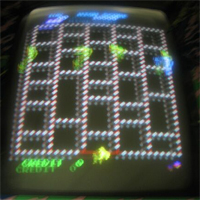 |
|
Altered Beast
Amidar Cherry Master ESWAT Great Swordsman Mario Bros M.V.P. Pit Boss S.S. RoadBlasters
Page Links
|
Amidar
Conversion - Konami Classic
Description: Amidar's basic format is similar to that of Pac-Man: the player moves around a fixed rectilinear lattice, attempting to visit each location on the board while avoiding the enemies. When each spot has been visited, the player moves to the next level. On odd numbered levels, the player controls an ape (in some versions labeled "Copier"), and must collect coconuts while avoiding headhunters (labeled "Police" and "Thief"). On even numbered levels, the player controls a paint roller (labeled "Rustler"), and must paint over each spot of the board while avoiding pigs (labeled "Cattle" and "Thief"). After each even level is a short bonus stage. Whenever a rectangular portion of the board is cleared (either by collecting all surrounding coconuts, or painting all surrounding edges), the rectangle is colored in, and bonus points are awarded. The game controls consist of a joystick and a single button labeled "Jump," which can be used up to three times per level. Pressing the jump button does not cause the player to jump, but causes the enemies to jump, enabling the player to walk under them. The enemies (and bonus stage pigs) in Amidar move deterministically, this is described in the game as "Amidar movement". Each normal-type enemy moves vertically from the top to the bottom of the screen, and then back to the top, and so on. While moving in a constant vertical direction, the enemy will take every horizontal turn available. Each level has one special enemy (the "Tracer", colored white) which, at the beginning of each stage, simply patrols around the perimeter of the network in a clockwise direction. However, following a certain number of "laps", The Tracer will begin to relentlessly pursue the player by following the path the player takes around the level. Since the Tracer moves at the same speed as the player, but does not mimic any pauses or hesitations the player makes, game play now becomes much more frantic, as too many mistakes and the Tracer will catch up to the player. Later levels increase difficulty by adding more complex game grids, and by having the Tracer pursue the player after fewer and fewer laps until, eventually, it will give chase from the very beginning of the level. Technical:
About My Game: I bought this game September 9, 2006 from eBay. This is the first game board I bought that is not JAMMA so I had to make an adaptor. I built the adaptor with some parts I got from JammaBoards.com but the game came up with a video problem but I later found out that the video ground to the monitor was not connected through my adaptor. Could be a loose chip or bad joint from shipping or a problem with how I wired the adaptor. Good news is that the sound works, it was advertised with a sound problem but it was just turned way down.
Repair Log:
10-07-06 |

